What is Link Building for SEO? [Complete Guide & Strategies]
If you are starting with SEO, one of the first terms you might encounter is link building. It might sound confusing to you why SEO experts pay so much attention to this process and what benefits they expect to get from there.
Luckily, we are here to answer all your questions with our comprehensive guide on link building.
What Is Link Building?
Link building is a set of tactics and practices that helps you increase the number and the quality of backlinks. Backlinks are hyperlinks pointing to your site that other websites have placed in their existing or new content.
SEO specialists do link building in both active and passive manners. Passive link building means that your SEO team increases the number of opportunities where other websites will naturally link back to your content. In contrast, active link building involves direct collaboration and negotiation with websites where you want your backlinks to appear.
We suspect that the first impression you have of link building is that it’s a pretty complex process. So, why should you invest in it?
Up next, we will explain to you why backlinks matter.
Why Is Link Building Important?
Link building is important because getting links from a number of relevant and authoritative websites (referring domains) will lead to the growth of your backlink profile, which is one of the most important ranking factors for improving your search engine optimization and your SERP rankings.
Search engines pay attention to backlinks as they can use them as indicators of your trustworthiness and authority. The logic is simple: if other websites mention you and link back to you in their content, then you probably have helpful, good content, and thus you are worth giving higher ranks.
Considering the value it can add to your SEO efforts (in terms of quality referral traffic and organic traffic for both B2B and B2C use cases), link building is worth all the time and resources you dedicate to it. Now let’s move on to understanding how exactly this strategy works, beginning with the backlinks themselves.
How Do Backlinks Work?
Let us imagine a situation when website A has placed a link in its content that takes users to website B when they click on it. If you are the webmaster of website A, then this link is an external link for you. If you are in charge of website B, then the link in question is your backlink.

In order to understand backlinks in more detail, let us look at them from two viewpoints – technical and marketing/SEO.
Technical: From this point of view, backlinks are ordinary URLs on the web page that appear as Anchor tags (also known as “a” tags) in the HTML. The only difference is that backlinks point to other websites (your website in this case) instead of the site where the website owners have placed them.
Let us illustrate this with an example. Imagine you are in charge of our website – digitalmarketersworld.com and just obtained a backlink from Example.com. This is what the backlink will look like on the Example.com HTML.
In this example, there are two elements that are important to us:
- The URL, which is https://dev.digitalmarketersworld.com/, and this is where the users will go when they click on the link. As this URL takes people to our website, the link in the example is a backlink for us.
- The anchor, which is “Learning Resources on Digital Marketing,” and this is the highlighted text in the content that will be clickable and take people to our website.
With the technical side clear, let us move on to the digital marketing and SEO point of view.
Search Engine Optimization: We mentioned in the previous section that search engines look at inbound links as signs of proof that your convent is valuable and your website is trustworthy. Here, we want to show in detail how it works in the example of Google search.
PageRank is Google’s algorithm for evaluating websites based on their link profile., and it is part of its overall Google search logic. The exact way PageRank works is not public information, but SEO experts know the general concepts behind it.
This is what PageRank looks like from a bird’s eye view.
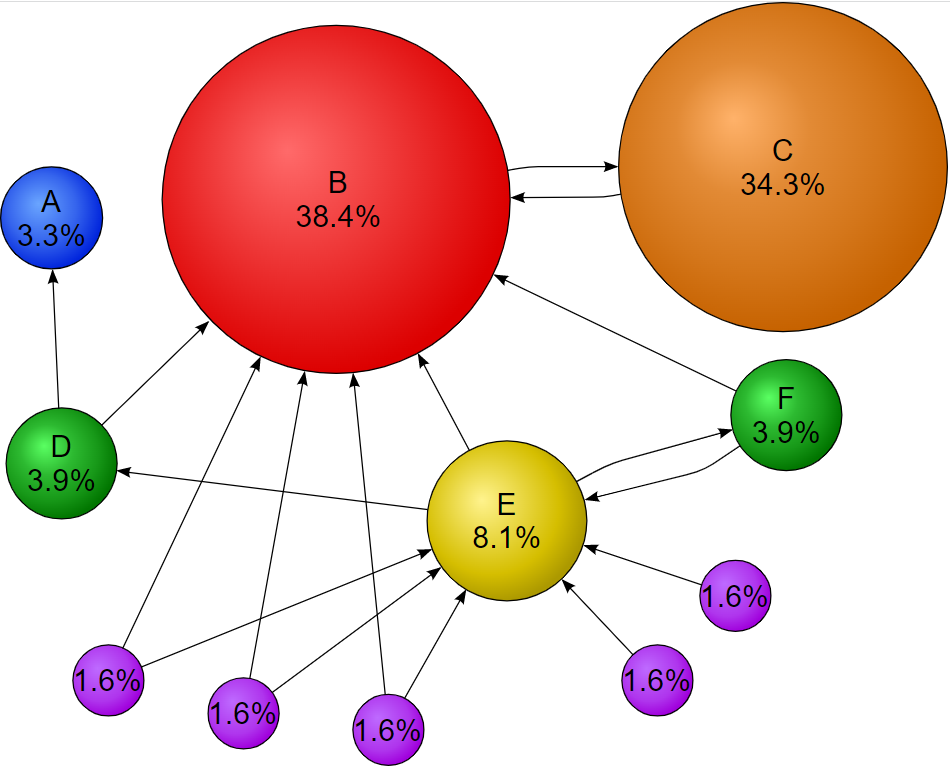
Essentially, every time you receive a backlink, you also receive part of the value of the website that has mentioned you. The size and trust of the website that gave you a backlink will also determine the value you are getting.
To conclude, backlinks are URLs pointing to your website and passing some of the value of the origin site onto your website. But not all backlinks work the same way. It really depends on their type. Thus, let us examine each backlink type and see how they behave.
4 Types of Links
Not all links are created equal, and it makes sense as backlinks can serve different purposes and have different origins. Therefore, search engines have classified links into different categories based on their purpose.
Here are four of the most common ones.
Type #1: Do-follow links
Although SEO specialists like to call them do-follow, these are the ordinary hyperlinks that you can place on a page. The reason the digital marketing world calls these links do-follow is that there are also no-follow links (more on them later), and there was a need to differentiate these two.
Do-follow links look like this in HTML:
As we can see, these are ordinary links without any special attributes or parameters.
From the perspective of search engines, do-follow links allow the crawling bots to follow along these links to the new website and pass the PageRank value to it.
Type #2: No-follow links
Unlike the previous type we discussed, no-follow links do not pass the PageRank value to the destination website directly.
This type of link was the invention of Google, Yahoo, and MSN in 2005 to help them combat spammy links and let webmasters devalue the links they did not want.
No-follow links look different in HTML too:
They carry the rel=”nofollow” attribute that tells the crawlers to ignore them and not visit the destination website.
Type #3: Sponsored links
Up next, we have the so-called sponsored links.
These are the backlinks that the webmaster added to their content as a result of direct sponsorship and monetary payment by the beneficiary site.
It is mandatory for this type of link to carry the sponsored tag so that search engines can treat them accordingly (similar treatment to no-follow). Here’s an example of a sponsored tag:
You can differentiate sponsored links thanks to their rel=”sponsored” attribute.
Type #4: UGC links
UGC is an abbreviation that stands for user-generated content.
It means that UGC links are the ones that users have added to the website in the form of comments, posts, etc. UGC helps search engine crawlers differentiate the user-created links from the regular ones found on the webpage.
UGC links, just like others in our list, carry a specific HTML attribute that lets you set them apart from others.
UGC helps web admins stop spiders from crawling the external links on their website from user posts or blog comments. This is especially popular on social media platforms.
To summarize, the way that search engines treat your backlinks depends on their type. Some will contribute to your PageRank, while others will not.
We have covered backlinks in enough detail, so let’s move on to the process of link building itself.
The 2 Main Types of Link Building
There are many different tactics and processes for building backlinks in the SEO sphere. Some of them are relatively time-consuming but deliver great long-term results, while others are easier to do but violate search engine rules and might get you in trouble.
In the world of search engine optimization, these two types of link building are better known as White hat and Black hat.
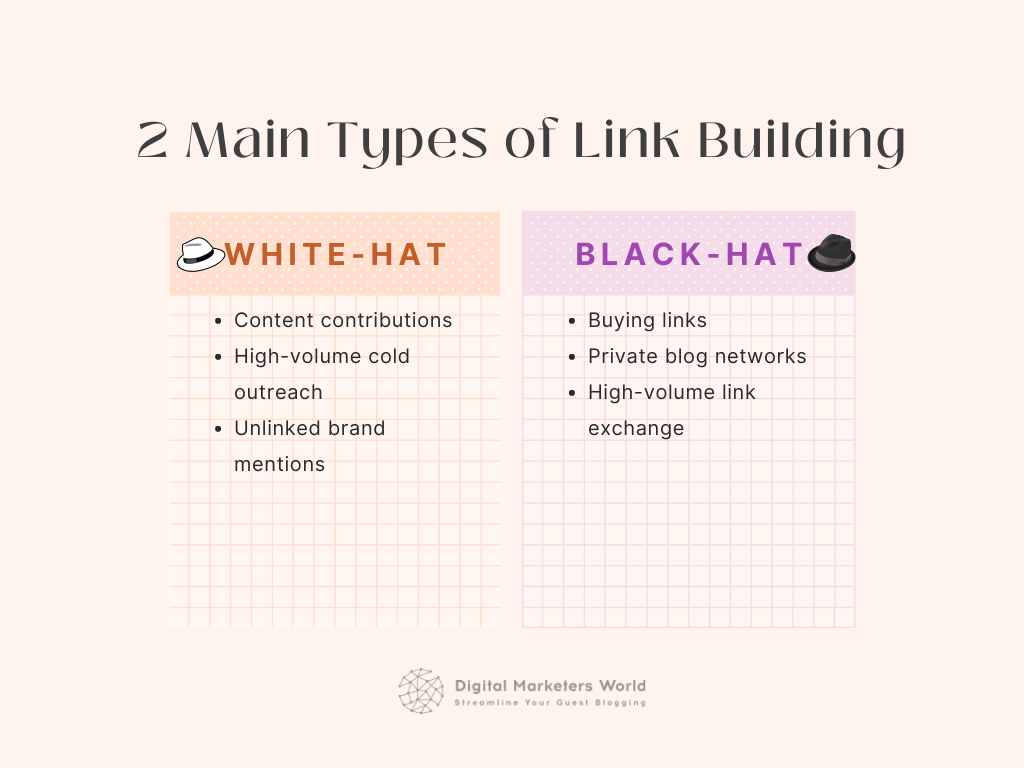
Let us see what each one means.
Type #1: White hat link building
White hat link building refers to all the off-page SEO practices that let you obtain new quality backlinks while staying in compliance with search engine rules and guidelines.
These practices ensure that your backlinks are relevant, come from high-authority websites, and add value to the content where you can find them.
Some of the common white hat tactics include guest posting with high-quality content, unlinked brand mentions, and others.
Type #2: Black hat link building
Unlike the white one, black hat link building is an umbrella term for tactics that violate the search engine rules (e.g., Google’s Webmaster Guidelines). When the search engine bot catches you performing black hat link building, you can face harsh penalties (Google added this after its penguin update).
Some notable black hat tactics are buying links, private blog networks (PBNs), link exchange, and others.
As we can see, when doing link building, you have a choice between fast and dangerous or slower but sustainable. Needless to say, white hat is the right path to take since it gets you high-quality links with long-term benefits.
But how do you differentiate between bad and good links? Our next section will cover that for you.
4 Factors That Make a Good Backlink
When building a backlink profile, the quality of backlinks plays a key role and affects your site’s rankings significantly. Thus, it is worth paying special attention to bringing in only the best links.
Backlink quality can depend on many factors, but these four matter the most.
Factor #1: Website authority
As backlinks are “votes of confidence” for search engines, it is important for them to know where the backlink came from. Backlinks from higher authority websites will contribute more to your rankings.
Website authority is not a public metric. Thus, you cannot know how search engines grade your site. However, some third-party companies have developed alternative metrics that can give you an “educated guess” of what your page authority is.
The most popular metric is Domain Authority which was the brainchild of Moz. Based on Backlinko research, average domain authority correlates with positions in Google search results.
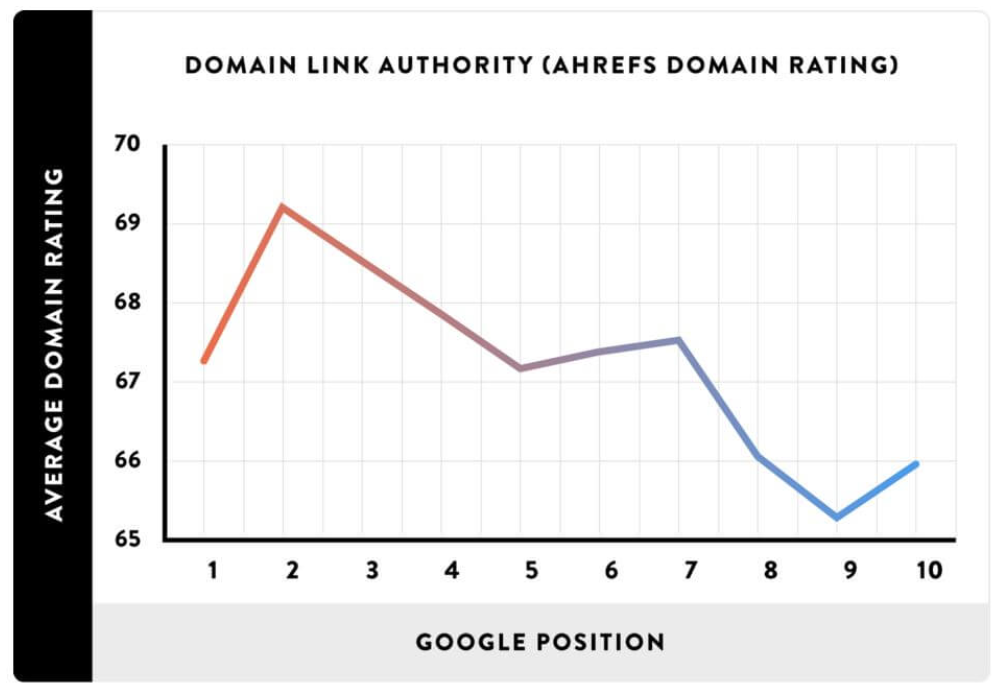
Thanks to this correlation, we can evaluate the websites from which we can get backlinks and understand if they are worth our link building campaign efforts.
Factor #2: Website relevancy
Relevancy is exceptionally important when it comes to backlinks.
Search engines will not consider backlinks valuable if they come from irrelevant sources. First of all, irrelevant links seem unnatural to them as it is unlikely that a website in a different niche would ever link back to you. Thus, it raises suspicion that you are trying to get artificial links and violating their rules. Secondly, irrelevant backlinks do not show a “vote of confidence” in your content.
As an example of relevance, if you are operating a plumber service in Chicago, then a relevant backlink would be from a plumbing website operating all over the U.S. (topic relevance) or a directory site listing Chicago plumbers (location relevance).
Factor #3: Website traffic
Up next, we have the traffic size, which is another metric that search engines use to evaluate the trustworthiness of websites.
The logic is straightforward: if you get millions of daily visitors, then you must be a more “legitimate” website than those with 100-200 visitors. Thus, getting a backlink from a large traffic website can contribute to your SEO.
Factor #4: Anchor text
Our final important factor is the anchor text, which is part of the text containing the URL to your own website.
Search engines pay attention to the anchor text and its relevance to your URL. Thus, if the anchor text contains your main keywords, then it increases the chances of going up in ranks.
To conclude, you can expect visible improvements in your rankings if you obtain backlinks from relevant sources with high authority and traffic and the right anchors.
We are finished with the white side of link building, now it is time to understand the dark side too.
4 Black-Hat Link Building Tactics to Avoid
That is true – black hat tactics are easier and less time-consuming compared to white hat ones. But you should not expect the same results in rankings from it, plus there is always the risk of getting a penalty.
To make sure that you recognize them, let us list several black hat practices for you.
Tactic #1: Paid links
We are not talking about outsourcing your link building activities to an SEO team who will use white hat tactics. Here you’re paying a monetary sum to the webmaster directly for adding your backlink on their pages.
Buying links is a violation of the webmaster guidelines of most search engines.
Tactic #2: Reciprocal links
In this case, you exchange links with another website – they add your backlink, and you add theirs.
Reciprocal links obviously look forced and low-quality in the eyes of search engines, as the chances are very low that these links were acquired naturally.
Therefore, you can get a penalty for such a practice.
Tactic #3: PBNs (Private blog networks)
Private blog networks are a group of blogger websites with relatively high PageRank that the black hat SEO expert obtains for the sole reason of putting links on them back to the website they want to promote. Sometimes they will ask for money to give lots of links from their PBN.
Tactic #4: Overuse of keyword-rich anchors
If your backlink anchors carry your target keywords, it is great news for you, as having keywords in the anchors contributes to your SEO. However, there is the other side of the coin.
If there are too many repeating anchors, it may appear suspicious to search engines and can hurt your SEO.
To summarize, if you can identify and avoid these practices, you will be able to get lots of links without sacrificing link quality.
Now it is time to look at the white hat practices and learn how they work.
5 Effective Link Building Strategies
Even though the white hat tactics take a bit more time than the black ones, their outcomes are vastly better thanks to the fact that you are getting high-quality and authentic backlinks.
To help you with your white hat link building activities, here are five well-performing tactics.
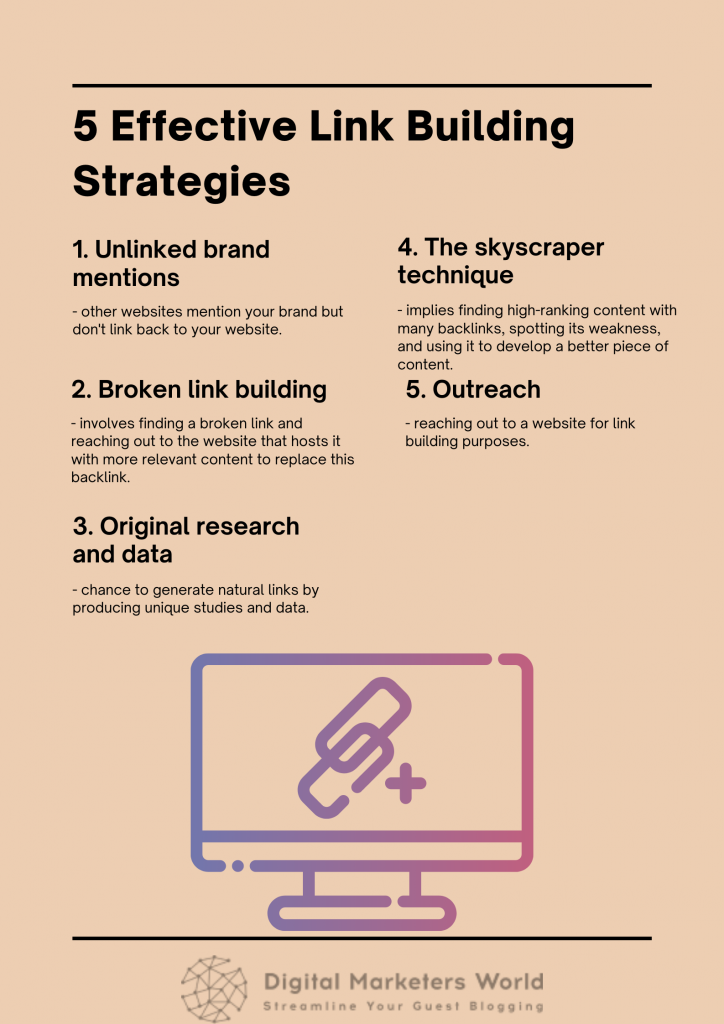
Now let’s discuss each one in more detail.
Strategy #1: Unlinked brand mentions
Unlinked brand mentions are the case when other websites talk about your company and brand and mention you in their content but forget to place a backlink to your website.
Another case is when they give you a backlink, but it is broken and does not redirect to your site.
In both cases, you can use special link building tools that can scan the internet for unlinked brand mentions and report to you. Here is an example report from SEO tool Ahrefs.
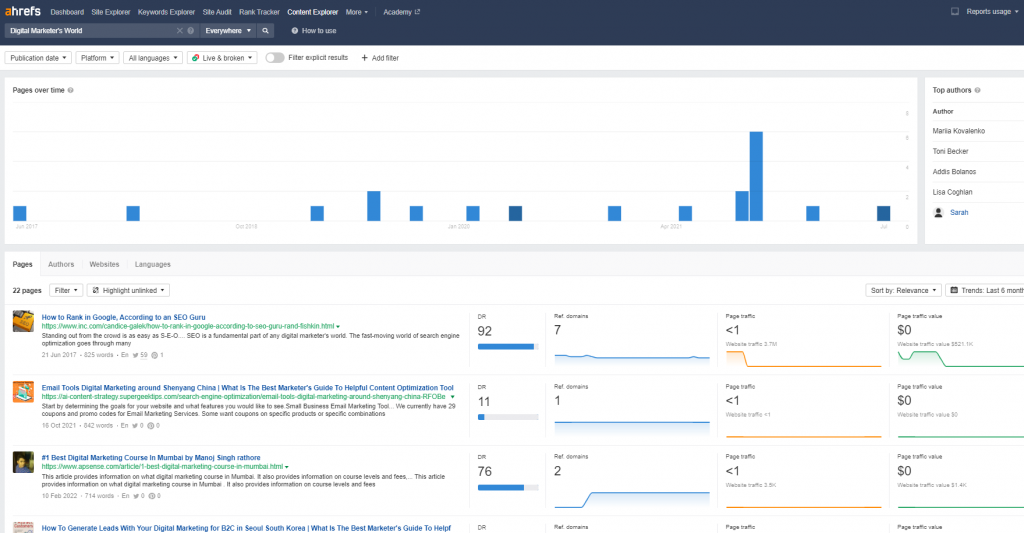
Then, you can reach out to these websites and request adding or fixing (a.k.a. link reclamation) your backlink.
Strategy #2: Broken link building
This strategy revolves around the fact that sometimes the backlinks in content become broken as the destination website either ceases to exist or simply removes the content you have linked to.
SEO tools are able to automatically scan and report these broken links to you too. Here’s the broken link report on Ahrefs.

In this report, you get the list of broken links, along with the webpage it is on, page traffic, DR, as well as the anchor tag of the link.
When you have this list of broken links, you can make content on your website that is relevant to the broken link, then contact the website owners, and ask them to remove that broken link and add a backlink to your site.
Strategy #3: Original research and data
This strategy is notable for its ability to generate natural links. Backlinks are natural when the website’s webmaster has added a backlink without your intervention.
If you manage to gather data that is relevant to your niche and topic, analyze it, and take valuable findings and statistics out of it, you can publish it in the form of great content like original research (e.g., an infographic).
Ultimately, many websites in your niche that find this research helpful will talk about your findings and statistics in their content and link back to you as the source of this data.
Strategy #4: The skyscraper technique
This link building technique relies on the human tendency to pick the best contestant among many options, and it applies to backlink sources too. If writers want to add a link to their content, they will pick the source with the best content.
To take advantage of it, you can find a piece of content with lots of backlinks and create competing content of better quality and value. Afterwards, you can contact the websites that gave that content backlinks and ask them to link back to you instead as your content is the best one out there.
Strategy #5: Outreach
Reaching out to websites for link building purposes is an essential part of your job, regardless of the technique you use (e.g. guest blogging or unlinked brand mentions).
Great outreach relies on several best practices:
- Link prospecting: the process of making a list of websites for outreach. Great lists bring great outreach results.
- Value added: always tell the webmaster about the benefits they will get from you.
- Linkable assets: you will need valuable content that the webmaster will be interested in linking to.
These are some of the most effective link building methods. Feel free to pick one or multiple of them and add them to your SEO strategy to help you improve your backlink profile.
Finally, let us give you a couple of valuable tips to further increase your effectiveness.
3 Powerful Link Building Tips
No matter which link building tactic you use, there are always best practices that apply to all of them.
Here is our pick of best practices for you to consider.
Tip #1: Relevancy is king
Quality links and a great backlink profile are all about a high level of relevancy.
Novice link builders commonly prioritize domain authority and the number of links over relevant and valuable links. This is a common mistake as, despite the value of domain authority, relevancy is far more important for quality backlinks.
Tip #2: Always personalize your outreach emails
Personalization is king too. Nobody likes to receive a generic bulk email that looks like spam, and the chances that webmasters will answer such a message are low.
Thus, make sure that each of your emails contains personalized information like the webmaster’s name, locations, website niche, and others.
Another way of personalizing is to use different templates for different segments of webmasters you are reaching out to.
Tip #3: Look at your competitors
A famous proverb says, “When in Rome, Do as the Romans Do.”
This rule applies to link building, too, as you can analyze the backlink profile of your competitors and have a sound understanding of what types of strategies are working for them and can likely work well for you too.
Can You Buy Link Building Services?
Yes, you can. There is no need to hire staff as there are many agencies specialized in lion building specifically that can help you.
Just make sure that the agency you are working with is trustworthy and does not use any black hat tactics, as it will hurt your reputation on the internet.
Now Over to You
As a key contributor to your search engine rankings and organic search traffic, link building is among the most valuable and important parts of every SEO expert’s life.
If you do link building right with the use of effective white hat tactics, you can expect to see significant improvements in your website’s ranks in search engine results.
Our blog at Digital Marketers World has become a valuable learning center for many novice and expert marketers. Make sure to check out other guides and content that we have for you there.

Sona Kalantaryan is a senior digital marketer with a creative past. Big fan of high cinema and well-optimized landing pages. She authors guides by sharing the best practices and does it the right way!
